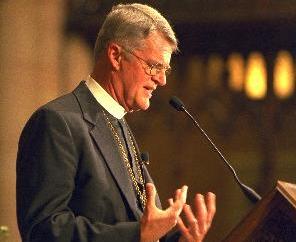The somewhat slower pace that characterizes summer is speeding up as autumn descends upon us and we begin again the round of activities that constitute our congregational life. This seems to me an opportune moment to reflect upon what most deeply shapes and forms us as authentic communities of faith. My own sense is that it is our worship, which is an encounter with the risen and living Christ, an event much larger than anything we can easily comprehend or define. Interestingly, a recent survey has indicated that what most has drawn new members to the Episcopal Church is our worship.
My understanding of what it means to be the church is derived largely from the sacraments. All sorts and conditions, all languages and cultures, are gathered into Christ’s risen body through baptism. That body matures and is built up through the Eucharist, in which our singularities meet and are reconciled in the sharing of the bread of life and the cup of salvation.
At an intuitive level I think we are aware that liturgy opens the door to another dimension of reality, a dimension we hunger for. Explanations and rationalizations cannot convey the full force of the encounter with the One who imbues the liturgy with its life-giving power. I think here of my own first experience of the Eucharist, which was at a weekday liturgy in the chapel of the school where I was a student. Though I had only the dimmest notion of what was going on, I was overwhelmed by the experience of a transcendent reality for which I had no explanation.
I am also put in mind of a late evening service I once attended in an urban cathedral. The nave was packed with young people sitting in the pews or lying on the floor resting their heads on back packs. They had given themselves over to the experience of the moment and were reverently absorbed in an ancient form of liturgical prayer. While the plain chant soared into the vaulting I found myself asking what deep mystery had laid hold upon these young people in such a way that they return to that sacred space week after week. Could it be that the risen Christ, speaking a language beyond words that can only be understood by the soul, had addressed these young people and drawn them there?
When we worship we are doing much more than entering into a ritual pattern. We are participating in the very life of Christ. And, at the heart of Christ’s life lies the paschal pattern of death and resurrection: multiple dyings and risings, losings and findings whereby we are shaped and formed and conformed to the image of the One whose name we bear. Liturgy, therefore, is dangerous stuff, not to be entered into unadvisedly or lightly. Perhaps this is why we sometimes protect ourselves from its force by limiting the level of our participation. We might observe it at a safe emotional distance or perhaps, particularly in the case of the priest, take on the role of “technician of the sacred,” which allows us to control the liturgy and to keep “the lion of the tribe of Judah” – one of the scriptural titles for the risen Christ – safely at bay.
The contemporary writer Annie Dillard says that if we had any idea what worship was truly about we would wear crash helmets to church. The words of our common prayer, she observes, are ones we have found we can successfully get through without getting killed! It is a strong image but indeed an appropriate reminder of the power of liturgy.
Not long ago I came across these words by a Benedictine monk, Dom Damasus Winsen, who played a very important role in my early formation as a priest. He had been deeply shaped by the liturgy and spoke of it with a passion and conviction that have stayed with me all these years. The sacraments, he observed, “are the continuation in the church here on earth of Christ’s redemptive work. They are the living mold of a Christian personality. They are the foundation of Christian community life. They are the bridge between the invisible and the visible, between the spiritual power of the risen Christ and this material universe. No Christian personality, no Christian community, no Christian civilization is possible without the sacraments.”
In a world where so many things seem unstable and unsure, the continuing presence of the risen Christ in word and sacrament affords us a place to which we can return, and from which we can go forth. And, through the various strains within the church itself, the Liturgy can be a place where we meet, not because we have reconciled all our opinions but because we have been reconciled beyond our wildest imaginings by the risen Lord. Because liturgy communicates to us the life of Christ it is always positive and filled with hope, and gives us the courage to live into an unknown future.
Let us therefore approach our liturgical celebrations in fear and trembling and with open and expectant hearts ready to encounter the One who desires so deeply to share the full mystery of his death and resurrection with us.
